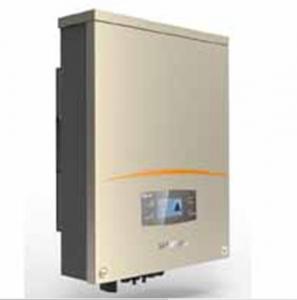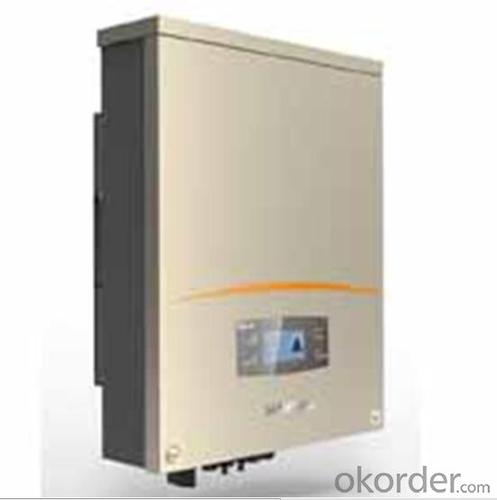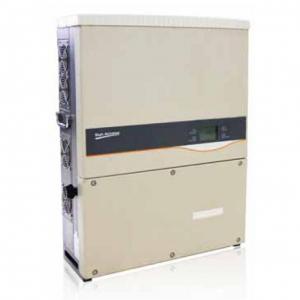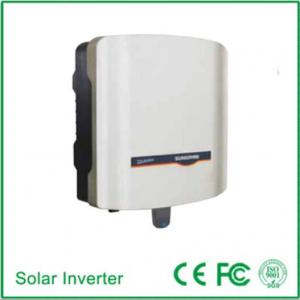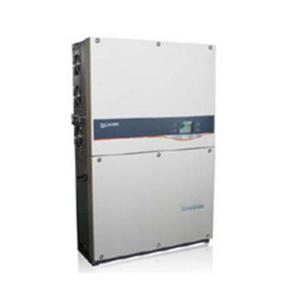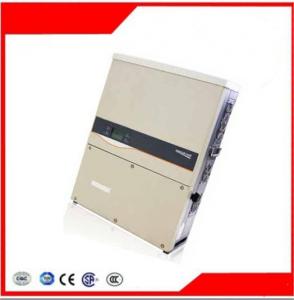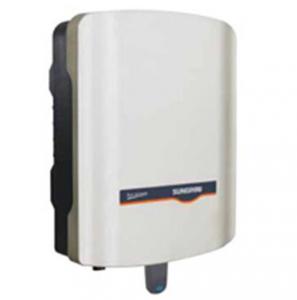24V Solar Inverter Solar Photovoltaic Grid-Connected Inverter SG6KTL-EC
- Loading Port:
- China Main Port
- Payment Terms:
- TT or LC
- Min Order Qty:
- 5000 unit
- Supply Capability:
- 3000000 unit/month
OKorder Service Pledge
OKorder Financial Service
You Might Also Like
1. Structure of Solar Photovoltaic Grid-Connected Inverter SG6KTL-EC Description
A solar inverter, or PV inverter, or Solar converter, converts the variable direct current (DC) output of a photovoltaic (PV) solar panel into a
utility frequency alternating current (AC) that can be fed into a commercial electrical grid or used by a local, off-grid electrical network. It is
a critical BOS–component in a photovoltaic system, allowing the use of ordinary AC-powered equipment. Solar inverters have special
functions adapted for use with photovoltaic arrays, including maximum power point tracking and anti-islanding protection.
2. Main Features of the Solar Photovoltaic Grid-Connected Inverter SG6KTL-EC
• Flexible design due to dual MPPT tracking that is equipped to obtain full nominal power, 3-phase supply
• High energy yield due to maximum efficiency up to 98.1%﹒competitive wholesale price.
• Low noise levels and internal consumption due to natural cooling
• Integrated theft protection﹒AC Voltage Range:150V-550Vac
• Access to Home WiFi system and enjoy cloud services via smart phones
• Integrated power management function, easy to receive the adjustable command from grid
• Extensive communication: RS-485, Ethernet, WLAN / WiFi, 4 digital inputs for ripple control receivers
• Product certification: TÜV, VDE 0126-1-1, EN 62109-1/-2, CE, G83/1, VDE-AR-N 4105
• Manufacturer certification: ISO 9001, ISO 14001, OHSAS 18000
3. Solar Photovoltaic Grid-Connected Inverter SG6KTL-EC Images

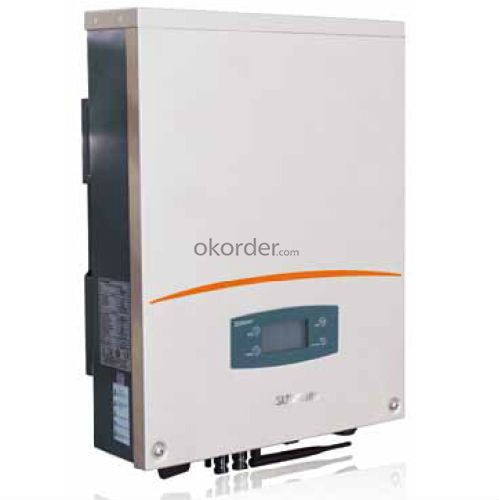
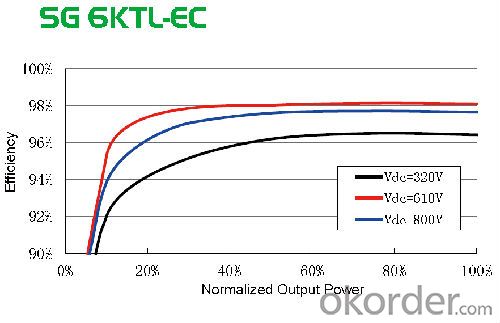
4. Solar Photovoltaic Grid-Connected Inverter SG6KTL-EC Specification
Input Side Data |
|
Max. PV input power | 6312W |
Max. PV input voltage | 1000V |
Startup voltage | 250V |
Nominal input voltage | 610V |
MPP voltage range | 200~900V |
MPP voltage range for nominal power | 320~800V |
No. of MPPTs | 2 |
Max. number of PV strings per MPPT | 1/1 |
Max. PV input current | 19.8A(9.9A/9.9A) |
Max. current for input connector | 10A |
Short-circuit current of PV input | 24.8A(12.4A/12.4A) |
Output Side Data |
|
Nominal AC output power | 6000W |
Max AC output power(PF=1) | 6000W |
Max. AC output apparent power | 6000VA |
Max. AC output current | 8.7A |
Nominal AC voltage | 3/N/PE,230/400Vac |
AC voltage range | 310~480Vac(May vary as per corresponding country's grid standard) |
Nominal grid frequency | 50Hz |
Grid frequency range | 45~55Hz(May vary as per corresponding country's grid standard) |
THD | < 3 % (Nominal power) |
DC current injection | <0.5 %In |
Power factor | >0.99@default value at nominal power, |
Protection |
|
Anti-islanding protection | Yes |
LVRT | No |
DC reverse connection protection | Yes |
AC short circuit protection | Yes |
Leakage current protection | Yes |
DC switch | Integrated |
DC fuse | No |
Overvoltage protection | III |
System Data |
|
Max. efficiency | 98.1% |
Max. European efficiency | 97.3% |
Isolation method | Transformerless |
Ingress protection rating | IP65 |
Night power consumption | <1W |
Operating ambient temperature range | -25~60℃(>45℃ derating) |
Allowable relative humidity range | 0~100% |
Cooling method | Natural cooling |
Noise | ≤29dB |
Max. operating altitude | 2000m |
Display | Graphic LCD |
Communication | Ethernet,RS485(RJ45 connector),4×Digital Inputs,Wifi |
DC connection type | MC4 |
AC connection type | Plug and play connector |
Certification | VDE0126-1-1,EN62109-1, |
Mechanical Data |
|
Dimensions(W×H×D) | 403×518×190mm |
Mounting method | Wall bracket |
Weight | 22kg |
5. FAQ of Solar Photovoltaic Grid-Connected Inverter SG6KTL-EC
Q1. What is the difference between inverter and solar inverter?
A1. Inverter only has AC inpput, but solar inverter both connect to AC input and solar panel, it saves more power.
Q2. What is the difference between MPPT&PWM?
A2. MPPT has higher efficiency, it can track the max power point and won't waste energy.
- Q: How does MPPT technology work in solar inverters?
- MPPT technology, or Maximum Power Point Tracking, is utilized in solar inverters to optimize the energy output of photovoltaic systems. It works by continuously tracking the maximum power point of the solar panel array, which is the voltage and current combination that allows the panels to generate the maximum power. The MPPT algorithm adjusts the operating voltage and current of the solar panels to match the optimal point, ensuring that the maximum amount of power is extracted from the solar array and converted efficiently by the inverter. By constantly adapting to changing environmental conditions, MPPT technology maximizes the solar energy harvest, improving system efficiency and overall performance.
- Q: How does a solar inverter handle grid frequency deviations?
- A solar inverter handles grid frequency deviations by constantly monitoring the grid frequency. When the grid frequency deviates from the standard range, the inverter adjusts its output frequency accordingly to match the grid frequency. This allows the inverter to maintain synchronization with the grid and continue injecting power efficiently, ensuring stability and reliability of the solar power system.
- Q: The function of photovoltaic grid - connected inverter
- By dc / dc conversion to increase or decrease the input voltage, adjust its output to achieve maximum efficiency.
- Q: How do you connect solar panels to a solar inverter?
- To connect solar panels to a solar inverter, you need to follow these steps: 1. Locate the positive (+) and negative (-) terminals on the solar panels. 2. Connect the positive terminal of the first solar panel to the positive terminal of the second panel using a solar PV cable or connector. Repeat this process for other panels if necessary. 3. Connect the negative terminal of the first panel to the negative terminal of the second panel using the same method as above. 4. Once all panels are connected in series or parallel, connect the positive terminal of the last panel to the positive terminal of the solar inverter. 5. Finally, connect the negative terminal of the last panel to the negative terminal of the solar inverter. It's important to ensure that the connections are secure and tightened properly to prevent any loose connections. Following the manufacturer's instructions and consulting a professional electrician or solar installer is recommended for a safe and efficient installation.
- Q: What is the role of a solar inverter in power factor correction?
- The role of a solar inverter in power factor correction is to adjust the power factor of the solar power system to ensure efficient energy conversion. It helps in balancing the reactive power and real power, leading to improved overall power quality and reduced system losses.
- Q: How does a solar inverter affect the voltage stability of a solar system?
- A solar inverter plays a crucial role in maintaining the voltage stability of a solar system. It converts the direct current (DC) produced by solar panels into alternating current (AC) that is used to power household appliances. By constantly monitoring and regulating the voltage, the solar inverter ensures that the electricity generated by the panels remains within the desired voltage range. This helps to maintain a stable and consistent power supply, protecting the solar system from voltage fluctuations and electrical damages.
- Q: Can a solar inverter be used in a solar-powered electric vehicle charging station?
- Yes, a solar inverter can be used in a solar-powered electric vehicle charging station. A solar inverter is responsible for converting the Direct Current (DC) generated by solar panels into Alternating Current (AC) that can be used to charge electric vehicles. Therefore, it is an essential component in a solar-powered EV charging station, allowing the electricity generated from solar panels to be compatible with the charging needs of electric vehicles.
- Q: How does a solar inverter communicate with monitoring systems?
- A solar inverter communicates with monitoring systems using various communication protocols such as Wi-Fi, Ethernet, cellular networks, or powerline communication. These protocols allow the inverter to transmit data such as energy production, system health, and performance metrics to the monitoring systems. This communication enables real-time monitoring, fault detection, and remote management of the solar system.
- Q: How does a solar inverter handle electromagnetic interference (EMI)?
- A solar inverter handles electromagnetic interference (EMI) by incorporating various filtering techniques and shielding mechanisms. These include the use of EMI filters, capacitors, and transformers to minimize the impact of EMI on the inverter's performance. Additionally, proper grounding and shielding of sensitive components help to reduce the risk of EMI interference. Overall, the design and implementation of these protective measures ensure that a solar inverter can effectively handle and mitigate electromagnetic interference.
- Q: How much maintenance is required for a solar inverter?
- Solar inverters typically require very little maintenance. They are designed to be reliable and durable, requiring minimal attention throughout their lifespan. Regular visual inspections to check for any debris or dust accumulation, as well as ensuring proper ventilation, are recommended. Additionally, monitoring the inverter's performance through software or online platforms can help identify any potential issues. However, in general, solar inverters are known for their low maintenance requirements, making them a reliable choice for renewable energy systems.
Send your message to us
24V Solar Inverter Solar Photovoltaic Grid-Connected Inverter SG6KTL-EC
- Loading Port:
- China Main Port
- Payment Terms:
- TT or LC
- Min Order Qty:
- 5000 unit
- Supply Capability:
- 3000000 unit/month
OKorder Service Pledge
OKorder Financial Service
Similar products
Hot products
Hot Searches
Related keywords
